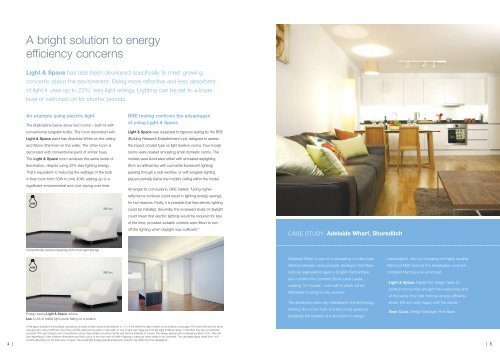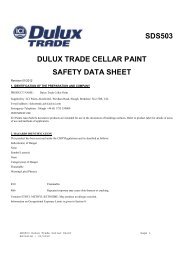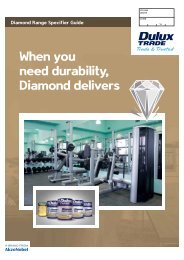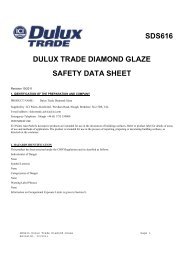Light & Space specifier brochure - Dulux Trade
Light & Space specifier brochure - Dulux Trade
Light & Space specifier brochure - Dulux Trade
Create successful ePaper yourself
Turn your PDF publications into a flip-book with our unique Google optimized e-Paper software.
A bright solution to energy<br />
efficiency concerns<br />
<strong>Light</strong> & <strong>Space</strong> has also been developed specifically to meet growing<br />
concerns about the environment. Being more reflective and less absorbent<br />
of light it uses up to 22% † less light energy. <strong>Light</strong>ing can be set to a lower<br />
level or switched on for shorter periods.<br />
An example using electric light<br />
The illustrations below show two rooms – both lit with<br />
conventional tungsten bulbs. The room decorated with<br />
<strong>Light</strong> & <strong>Space</strong> paint has Absolute White on the ceiling<br />
and Moon Shimmer on the walls. The other room is<br />
decorated with conventional paint of similar hues.<br />
The <strong>Light</strong> & <strong>Space</strong> room achieves the same levels of<br />
illumination, despite using 22% less lighting energy.<br />
That’s equivalent to reducing the wattage of the bulb<br />
in that room from 50W to only 40W, adding up to a<br />
significant environmental and cost saving over time.<br />
BRE testing confirms the advantages<br />
of using <strong>Light</strong> & <strong>Space</strong><br />
<strong>Light</strong> & <strong>Space</strong> was subjected to rigorous testing by the BRE<br />
(Building Research Establishment Ltd), designed to assess<br />
the impact of paint type on light levels in rooms. Four model<br />
rooms were created simulating small domestic rooms. The<br />
models were illuminated either with simulated daylighting<br />
(from an artificial sky with cool white fluorescent lighting)<br />
passing through a side window, or with tungsten lighting<br />
placed centrally below the model’s ceiling within the model.<br />
Amongst its conclusions, BRE stated: “Using higher<br />
reflectance surfaces could result in lighting energy savings,<br />
for two reasons. Firstly, it is possible that less electric lighting<br />
360 lux<br />
could be installed. Secondly, the increased levels of daylight<br />
could mean that electric lighting would be required for less<br />
of the time, provided suitable controls were fitted to turn<br />
off the lighting when daylight was sufficient.”<br />
CASE STUDY: Adelaide Wharf, Shoreditch<br />
Conventional colours requiring 22% more light energy<br />
360 lux<br />
Adelaide Wharf is part of a pioneering London-wide<br />
initiative between urban property developer First Base,<br />
national regeneration agency English Partnerships<br />
and construction partners Bovis Lend Lease,<br />
creating 147 homes - over half of which will be<br />
affordable housing for key workers.<br />
The developers were very interested in the technology,<br />
consumption. Also by choosing the highly durable<br />
Diamond Matt formula the developers could be<br />
confident that the look would last.<br />
“<strong>Light</strong> & <strong>Space</strong> helped the design team to<br />
achieve homes that are light and welcoming and<br />
at the same time help improve energy efficiency<br />
levels. We are really happy with the results.”<br />
Energy-saving <strong>Light</strong> & <strong>Space</strong> colours<br />
Lux A unit of visible light power falling on a surface<br />
making the rooms look and feel more spacious<br />
alongside the benefits of a revolution in energy<br />
Sean Cook, Design Manager, First Base<br />
4 |<br />
†This figure is based on theoretical calculations on pairs of bare rooms of dimensions 4 × 3 × 2.4m where the light incident on all surfaces is averaged. The rooms all have the same<br />
mid-grey floor colour (LRV 50). They have a white ceiling and a colour on the walls. In one of each pair these are from the <strong>Light</strong> & <strong>Space</strong> range. In the other they are conventional<br />
products. The <strong>Light</strong> & <strong>Space</strong> and conventional colours have similar hue (colour family) and chroma (intensity of colour). The energy savings will not always equate to 22%. They will<br />
vary depending on the contents, dimensions and floor colour of the room and will differ if lighting in particular areas needs to be controlled. The calculated figure varies from 14%<br />
to 28% depending on the wall colour chosen. The actual light energy savings achieved in practice may differ from the calculations.<br />
| 5

















